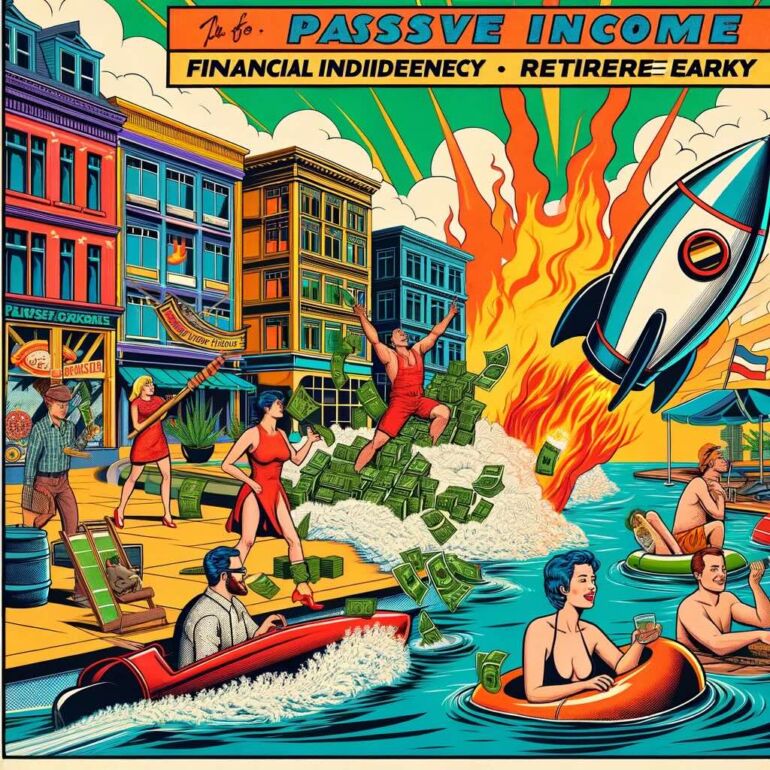Imagine sipping on a warm latte on a breezy Sunday morning while your bank account balloons, not because you’re slaving away in a cubicle, but because you’ve unlocked the magic formula of money making money. Welcome, my friends, to the alluring world of passive income.
Passive income, in its simplest form, is earnings derived from a venture in which a person is not actively involved. It’s the holy grail of personal finance – the art of detaching your income from your time. Instead of trading hours for dollars, passive income sources work around the clock for you, even when you’re sleeping, lounging on a beach, or exploring a new hobby. It’s like having diligent minions toiling away to fill your coffers while you live your life in all its richness.
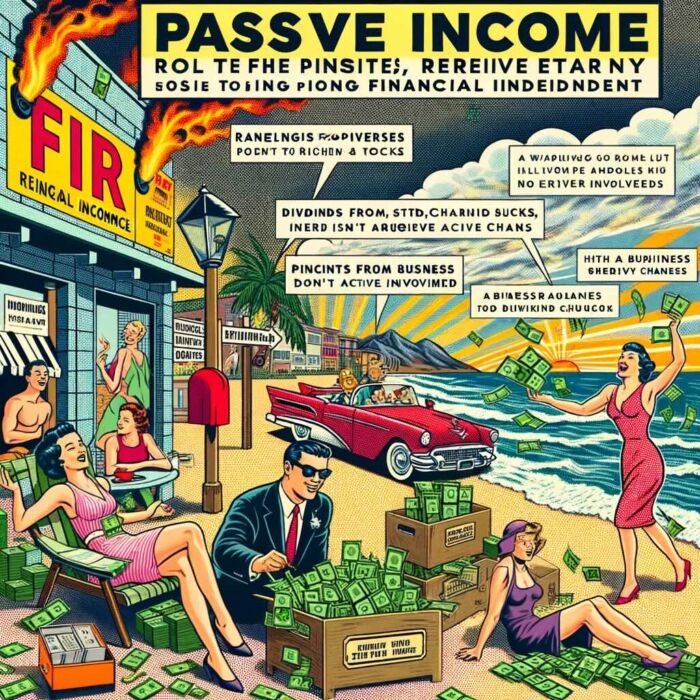
Passive Income and the FIRE (Financial Independence, Retire Early) Movement
Now, you might be wondering, what has this got to do with the FIRE movement? Well, think of passive income as the secret sauce, the rocket fuel propelling you towards your goal of financial independence and early retirement.
In the FIRE journey, your savings rate is crucial. But what’s equally, if not more, powerful is how you put those savings to work. And that’s where passive income comes into play. By cultivating passive income streams, you create a self-sustaining financial ecosystem that feeds and grows itself, accelerating your progress towards FIRE.
The FIRE ethos is all about decoupling work from income, and there’s no better way to do that than by establishing robust passive income streams. In other words, passive income isn’t just a nice-to-have in your FIRE journey; it’s a must-have.
So, buckle up and put on your financial explorer hats as we embark on a fascinating journey into the world of passive income and its role in fueling your journey to financial independence and early retirement. Let’s unravel the secrets of building wealth while sleeping!

The Power of Passive Income
Have you ever dreamt of earning money while you sleep, travel, or spend quality time with your family? If the answer is yes, then you’re envisioning the power of passive income. This might seem like an exaggerated or even unreachable concept, but I assure you, it’s within the realm of possibility. The beauty of passive income lies in its capacity to fuel your wealth-building journey with considerably less active involvement. And if you manage to diversify these passive income streams, you’ll find yourself riding the high seas of financial freedom.
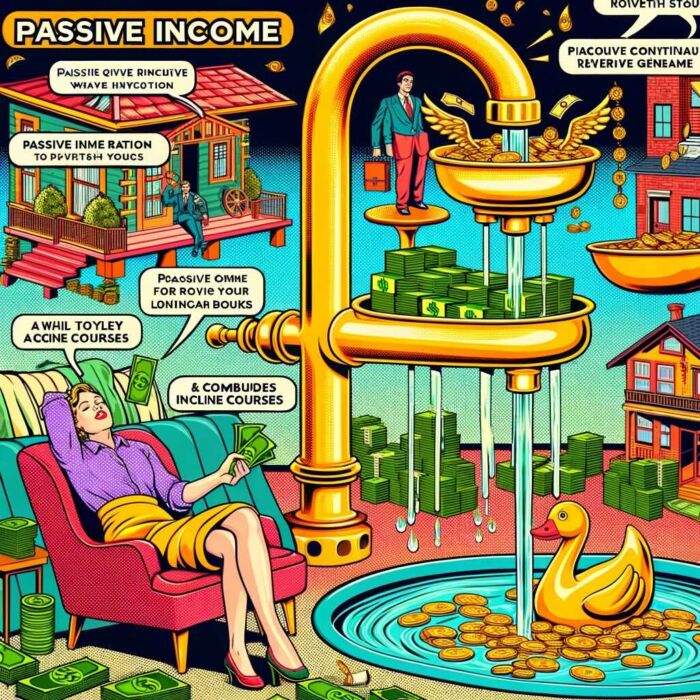
How passive income contributes to wealth-building
Wealth-building isn’t just about accumulating a massive fortune. It’s about achieving financial freedom where your income sources are not solely dependent on your active work hours. So, where does passive income fit into this picture?
The power of passive income lies in its ability to generate revenue continuously without the requirement for you to be constantly involved. Imagine a faucet that keeps dripping dollars even when you’re not turning the knobs. It’s like the golden goose from the fairy tale, laying an unending string of golden eggs!
Now, this doesn’t mean passive income comes without effort. It typically requires an upfront investment, either in the form of time, money, or both. For instance, investing in real estate and renting it out can create a steady cash flow, but it requires a substantial initial financial investment. On the other hand, writing a book or creating an online course might demand more of your time than your money. But once these income streams are set up and start flowing, they can contribute significantly to wealth-building, offering a return on your investments that far outweighs the initial effort.
Passive income also affords you the luxury to focus on long-term financial goals. With a steady flow of income trickling in, you’re less likely to be forced into selling your long-term investments prematurely due to financial constraints. The compounded returns from these long-term investments can then substantially accelerate your wealth-building journey.
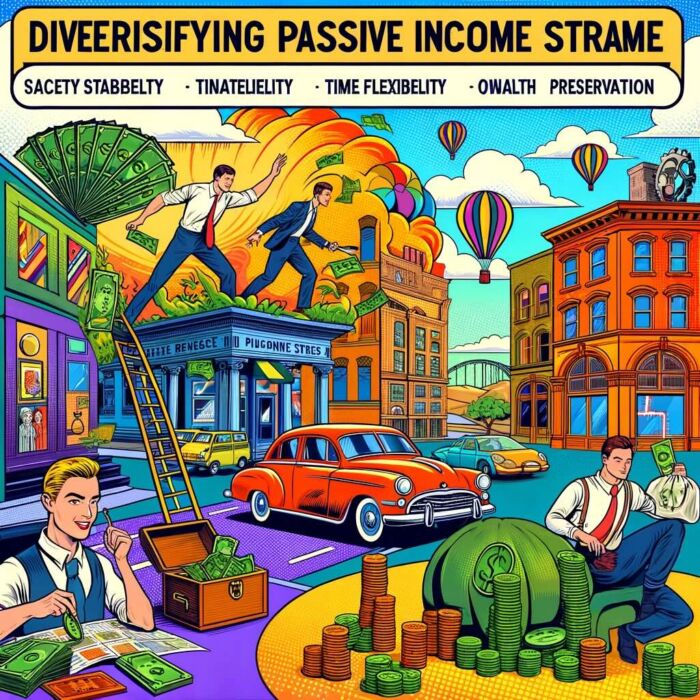
Benefits of diversifying income sources with passive income streams
Diversification, a concept as old as time itself, is crucial to any successful wealth-building strategy. Why? It spreads your risk. If one of your income streams faces a downturn, the others can help to keep you afloat. Diversifying with passive income streams adds a new level of resilience to your financial profile.
- Reduces Economic Risks: Relying on a single source of income, such as a monthly salary, is risky, especially in uncertain economic times. Passive income streams can act as a safety net, providing financial stability if your primary income takes a hit.
- Potential for Greater Earnings: Every passive income stream you set up has the potential to increase your total income. As these income streams require less active involvement, you can keep adding to your portfolio without overstretching yourself.
- Offers Time Flexibility: The time you free up by generating passive income can be used to explore new opportunities, learn new skills, or simply improve your quality of life. Remember, time is the most valuable asset.
- Acts as a Stepping Stone to Financial Independence: By diversifying your income, you’re reducing dependency on your primary job. This could eventually lead to financial independence, giving you the freedom to pursue your passions or retire early.
- Helps in Wealth Preservation: Passive income streams, especially investments, can be a great hedge against inflation. Real estate rentals, dividend-paying stocks, and index funds are some options that usually appreciate over time, helping preserve and grow your wealth.
To wrap it up, harnessing the power of passive income and diversifying your income streams can be a game-changer in your financial journey. It opens up avenues for risk reduction, wealth preservation, and financial independence. Remember, it’s not just about the destination (wealth), but also about the journey (income streams). If you equip your boat (financial strategy) with sturdy sails (diversified passive income streams), navigating the sea of wealth-building will be a smoother and more enjoyable journey!
source: Rose Han on YouTube
Popular Passive Income Streams
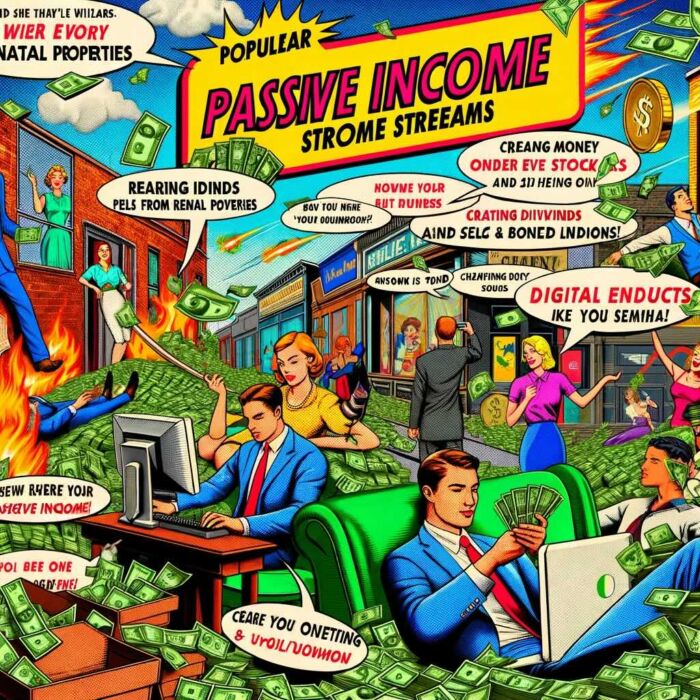
“Show me the money!” – we might not be in a Jerry Maguire movie, but we’re definitely getting there. We’re now diving into the popular passive income streams and giving you the nitty-gritty of what they entail. We’ll be touching base with real estate, stocks, bonds, royalties, and a few more lucrative routes on this financial treasure map. So, let’s get down to business.
Popular Passive Income Methods
- Real Estate: Real estate investments are a classic route to generate passive income. This can involve rental income from properties you own or returns from real estate investment trusts (REITs). For those who have some cash to spare and don’t mind a little legwork initially, this might be your ticket to steady passive income.
- Stocks: Investing in dividend-yielding stocks is another excellent strategy. When you own a company’s stock, you own a piece of that company. If it performs well, you get a share of the profits in the form of dividends.
- Bonds: Bonds are basically IOUs issued by governments or corporations looking to raise funds. When you buy a bond, you’re lending your money to the issuer for a certain period. In return, they agree to give you interest payments at regular intervals and return the principal when the bond ‘matures’.
- Royalties: Are you an artist, author, or inventor at heart? Royalties could be your path to passive income. Every time someone buys your book, plays your music, or uses your patented invention, you earn a royalty. Even better, if you license your work, you’ll continue earning for as long as your work is in use.
- Peer-to-Peer Lending: Thanks to the internet, lending money isn’t just a bank’s game anymore. Platforms exist that allow you to lend money directly to individuals or small businesses in return for interest payments. It’s like being your own mini bank!
Pros and Cons of Each Income Stream
- Real Estate:
- Pros: Real estate can provide a consistent income stream and potential appreciation over time. Plus, it’s a tangible asset – something you can see and touch.
- Cons: It requires substantial upfront capital. It can also be management-intensive if you’re dealing with rental properties, requiring you to handle tenants, maintenance, and potential vacancies.
- Stocks:
- Pros: Stocks have the potential for high returns, especially if you invest in high-growth companies. Plus, dividends can provide a regular income stream.
- Cons: The stock market can be volatile, meaning your investments can go down as well as up. It also requires some knowledge and understanding of market trends to invest effectively.
- Bonds:
- Pros: Bonds offer a fixed return, which can be a reliable source of passive income. They’re generally less risky than stocks.
- Cons: The returns from bonds are usually lower than those from stocks or real estate. Also, if the issuer defaults, you may not get your money back.
- Royalties:
- Pros: Royalties can provide income for an extended period without you having to lift a finger after the initial effort. It’s a way to monetize your creativity or intellectual property.
- Cons: It’s not always easy to create something that will generate significant royalties. The income can also be unpredictable and may dwindle over time.
- Peer-to-Peer Lending:
- Pros: It offers a higher return than traditional savings accounts or bonds. You also get to choose who to lend to, giving you control over your investments.
- Cons: The risk of borrowers defaulting is real. Plus, it’s a relatively new industry, and regulatory protections may not be as robust as with traditional investments.
These are just a few of the multitude of passive income streams you can explore. The best part? You don’t have to choose just one! Mix and match according to your interests, risk tolerance, and financial goals. The world of passive income is your oyster – it’s time to start shucking!
source: Unconventional Wealth Ideas on YouTube
Building a Passive Income Portfolio

Ready to roll up your sleeves and start building your treasure trove of passive income? It might feel a bit like stepping into a jungle with no map, but fear not! I’m here to be your guide, and together we’ll carve out a path toward financial freedom.
Step-by-Step Guide on Starting to Build Passive Income Streams
- Assess Your Financial Situation: You can’t set out on a journey without knowing your starting point. Take a hard look at your current financial state, your income, savings, expenses, and debts. You need a clear picture of your assets and liabilities.
- Define Your Financial Goals: Why are you seeking passive income? Is it to achieve financial independence, build an emergency fund, retire early, or maybe fund your world travels? Defining clear, actionable goals gives your journey a direction.
- Educate Yourself: Passive income isn’t a ‘set and forget’ deal. Each passive income stream has its nuances and requires some level of understanding. Read books, take courses, follow reputable finance blogs, or seek advice from a financial advisor.
- Choose Your Passive Income Streams: Based on your risk tolerance, the capital you have available, and the amount of time you can invest, choose one or several passive income streams to pursue. This could range from investing in stocks and bonds, purchasing rental properties, or starting a side business.
- Start Small: Don’t pour all your resources into a single venture right away. Start small, test the waters, learn from the experience, and scale as you grow more confident and comfortable.
- Regularly Review and Adjust: Once your passive income streams are up and running, don’t forget to review them regularly. Are they meeting your goals? Do you need to adjust or diversify further?
Important Factors to Consider
- Risk Tolerance: This is essentially how much variability in returns you’re willing to withstand. If the thought of your investments decreasing in value makes you lose sleep, you likely have a low risk tolerance and should steer towards more stable income streams like bonds or rental income.
- Capital: Your available capital will significantly influence your passive income choices. Real estate and certain businesses can require significant initial investments, whereas starting a blog or investing in stocks can be done with smaller amounts.
- Time Investment: Some passive income streams require a substantial initial time investment. Writing a book, creating a course, or setting up a blog can take months before they start generating income. On the other hand, purchasing dividend stocks or bonds can start generating income almost immediately, given you’ve done your homework.
- Tax Implications: Different income streams can have different tax implications. Understand how your passive income will be taxed to avoid unpleasant surprises come tax season.
- Diversification: The age-old saying, “don’t put all your eggs in one basket” holds true here. Diversifying your passive income streams can safeguard you against volatility in any one area.
Building a passive income portfolio is much like growing a garden. You plant various seeds (income streams), water and tend to them (manage and review), and over time, you get to enjoy a bounty of fruits (income). It requires patience, diligence, and a sprinkle of courage, but the harvest – a steady flow of income – is well worth the effort!
source: Mark Tilbury on YouTube
Passive Income and FIRE: A Match Made in Financial Heaven
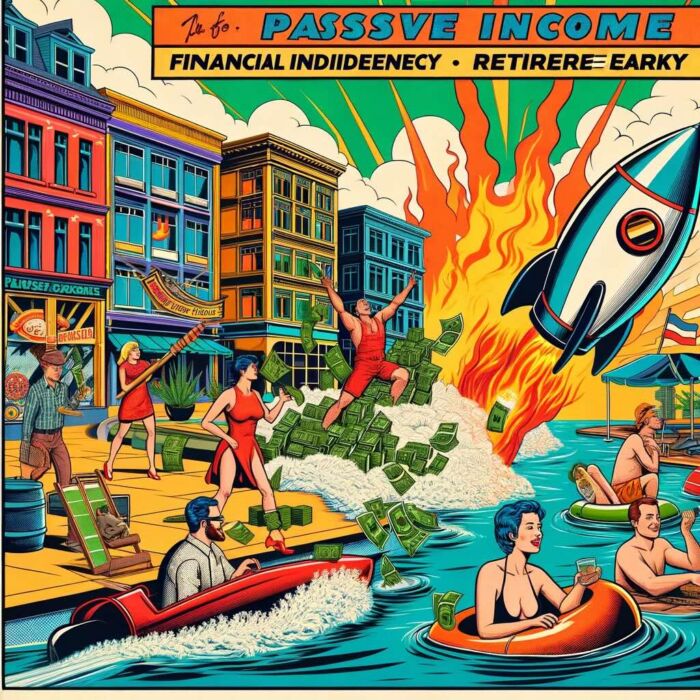
The holy grail of personal finance – the FIRE movement. FIRE, which stands for Financial Independence, Retire Early, has ignited the imaginations of many a millennial and beyond. So, where does passive income fit into this smoldering equation?
How Passive Income Accelerates the FIRE Journey
The FIRE philosophy is all about saving and investing aggressively, typically around 50-75% of your income, so that you can retire early and live off the returns of your investments. Passive income is like the secret sauce that spices up this journey, giving it an extra kick and flavor.
Here’s how: By creating and nurturing multiple streams of passive income, you increase your total income without proportionally increasing your active work hours. This means you have more money to save and invest towards your FIRE goal. The magic doesn’t stop there. Once these passive income streams are well-established, they continue to churn out cash even when you’re not actively working on them. This can potentially cover your living expenses, letting you retire from active work much sooner.
In short, passive income not only accelerates the “FI” part of FIRE by boosting your saving and investing power but also brings the “RE” part closer to reality by providing a continuous income stream even in the absence of active work.
Real-life Examples of Individuals Who Achieved FIRE through Passive Income
- Meet Robert, the Rental Mogul: Robert was an engineer with a passion for real estate. Starting with a small two-bedroom apartment, he slowly built a portfolio of rental properties. His strategy was simple – buy, renovate, rent, refinance, and repeat. His rental income, combined with his engineering salary, was aggressively invested. In his early 40s, he achieved his FIRE goal, with his rental properties providing a steady income covering his living expenses.
- Say hello to Julia, the Dividend Duchess: Julia started investing in dividend-paying stocks early in her career. She chose stable, blue-chip companies that had a history of consistent dividend payments. Over the years, she amassed a significant portfolio, with the dividends reinvested to buy more shares. By her late 30s, her dividend income surpassed her expenses, and she happily bid adieu to her 9 to 5 job.
- Meet Sam, the Blogging Baron: Sam started a personal finance blog in his spare time. Initially, it was more of a hobby, but as his blog gained popularity, it started earning advertising revenue and affiliate commissions. He also created an online course on budgeting and investing. In his early 40s, his blog and course were generating enough income for him to reach his FIRE goal.
Each of these individuals embarked on different paths, but they had two things in common – a well-thought-out passive income strategy and the FIRE spirit. And the result? A match made in financial heaven! Achieving FIRE is not an easy feat, it requires determination, discipline, and creativity. But with passive income in your financial toolkit, the journey becomes not only possible but also a thrilling adventure. Light your FIRE, let passive income fuel it, and savor the warmth of financial independence!
source: The Plain Bagel on YouTube
The Risks of Passive Income
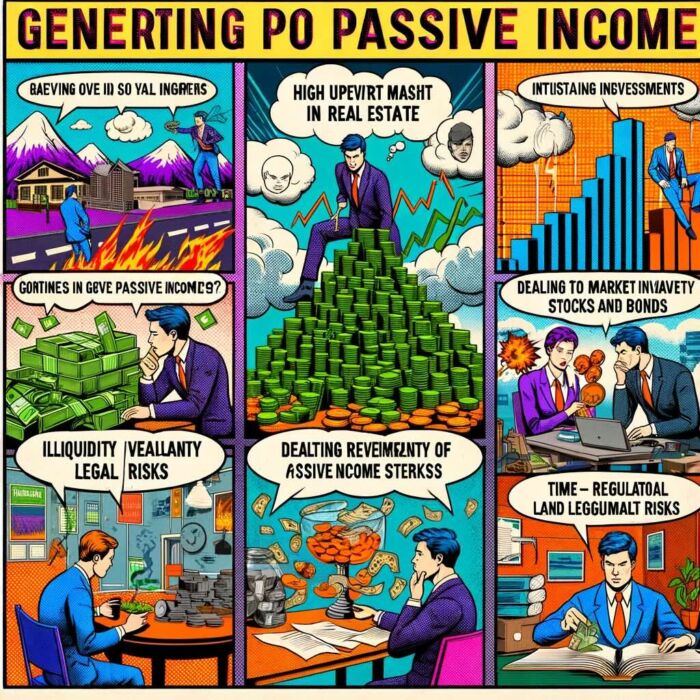
Life is full of surprises, and not all of them are of the pleasant variety, particularly when it comes to the financial world. While the dream of earning money while you sip pina coladas on a beach is tantalizing, it’s only fair that we take off our rose-tinted glasses for a moment and address the potential risks and challenges in the realm of passive income.
Potential Risks and Challenges of Generating Passive Income
- High Upfront Investment: Many passive income streams, such as real estate or starting a business, require a significant initial investment. This can be a substantial risk if the venture doesn’t pan out as expected.
- Market Volatility: Investments in stocks, bonds, and real estate are subject to market risks. Economic downturns, changes in interest rates, or unforeseen market events can impact your investment value and income.
- Illiquidity: Some passive income investments, especially real estate, can be hard to sell quickly without taking a loss. This lack of liquidity can be a problem if you need cash urgently.
- Regulatory and Legal Risks: Certain forms of passive income, such as peer-to-peer lending or royalties, might be subject to legal and regulatory risks. Changes in laws or regulations can impact your income or even the viability of the income source itself.
- Time-Consuming: While the aim is to generate “passive” income, the initial setup often requires substantial time and effort. Even afterwards, some maintenance or oversight might be needed.
Strategies to Mitigate These Risks
- Do Your Homework: Knowledge is your best defense. Understand the ins and outs of the income stream you’re getting into. Read, research, attend seminars, or seek professional advice if needed.
- Diversify: Spreading your investments across various assets and income streams can help reduce the risk of a single failing venture wreaking havoc on your financial situation. Remember, variety is the spice of life (and passive income).
- Set Aside an Emergency Fund: An emergency fund acts as a financial buffer against unforeseen events. It’s recommended to have at least 3-6 months of living expenses set aside in an easily accessible account.
- Regular Monitoring: Keep a close eye on your passive income ventures. Regular review and adjustments can help you detect issues early and take corrective action before they escalate.
- Consider Insurance: Depending on your passive income source, insurance might be a prudent option. For instance, landlord insurance for rental properties or business insurance for side ventures can protect you from substantial losses.
Navigating the passive income seas isn’t always smooth sailing. It’s crucial to be aware of potential storms and have a plan to weather them. As in life, the financial journey is filled with both opportunities and risks. But with a compass of knowledge, a map of diversification, and a lifeboat of an emergency fund, you can set sail with confidence towards your destination of financial freedom!
source: Ruri Ohama on YouTube
12-Question FAQ: Passive Income Streams for FIRE – Building Wealth While Sleeping
1. What exactly is passive income, and how is it different from active income?
Passive income is money earned with minimal ongoing effort after the initial setup, while active income requires continuous work (like a salary or freelance gig). Examples include dividends, rental income, and royalties that continue generating cash even when you’re not actively working.
2. Why is passive income crucial for the FIRE movement?
For FIRE (Financial Independence, Retire Early) enthusiasts, passive income is the key to replacing a traditional paycheck. It allows investors to decouple their time from money, providing financial freedom long before traditional retirement age.
3. How can passive income accelerate financial independence?
Passive income adds extra cash flow that can be reinvested into appreciating assets. This creates a compounding effect—your money continuously works for you, shrinking the time needed to reach your financial independence number.
4. What are the most popular types of passive income streams?
Common examples include real estate rentals, dividend-paying stocks, bonds, royalties from creative works, and peer-to-peer lending. Digital products, affiliate marketing, and YouTube ad revenue are also growing sources of passive income.
5. How much initial capital do I need to start earning passive income?
It varies widely. Some methods, like creating a blog or digital course, require more time than money, while real estate or dividend portfolios need significant upfront investment. The key is to start small and scale gradually.
6. Can I diversify passive income sources to reduce risk?
Absolutely. Diversification spreads your risk across different asset types—so if one underperforms, others can keep your cash flow steady. Combining real estate, dividend stocks, and digital income sources creates resilience.
7. What are the tax implications of passive income?
Tax rules differ by country and income type. For instance, rental income and dividends are usually taxable, but some deductions or tax-advantaged accounts may reduce your burden. It’s best to consult a tax professional to optimize efficiency.
8. How long does it take to build sustainable passive income?
There’s no overnight success here. It can take months or even years to establish streams that generate reliable income. The effort, however, compounds over time—much like the investments themselves.
9. What are the biggest risks of relying on passive income?
Risks include high upfront costs, market volatility, illiquidity, and changing laws or tax codes. Additionally, the “passive” label can be misleading—many income streams require active maintenance, especially in the early stages.
10. How can I mitigate the risks associated with passive income?
Educate yourself before investing, diversify your sources, maintain an emergency fund, and review your portfolio regularly. These proactive steps ensure your passive income remains reliable even in downturns.
11. What real-life examples exist of people reaching FIRE through passive income?
Examples include investors living off dividends, landlords whose rent covers expenses, and online creators whose digital products or blogs fund their lifestyles. Each uses different vehicles, but all rely on consistent reinvestment and discipline.
12. How can I start building passive income today?
Start by identifying your skills, interests, and available capital. Choose one stream—like dividend investing or an online side business—educate yourself, and take small, consistent action. Over time, you’ll build momentum toward financial independence.
Conclusion: Potential of passive income as part of a FIRE strategy
So, dear wealth-seekers, we’ve come to the end of our financial odyssey, having journeyed from the towering cliffs of wealth-building, through the dense forests of diversification, and across the raging rivers of risk. We’ve demystified the mythical beast of passive income and illuminated its role as a potent ally in your quest for FIRE – Financial Independence, Retire Early.
Passive income is no longer a secret whispered in the hallowed halls of the financial elite. It’s a practical strategy for all of us mere mortals, an antidote to the monotony of a 9 to 5 life. When wielded correctly, passive income has the power to fast-track your journey to financial independence, enabling you to retire early if you so wish, or simply live life on your terms.

Remember our intrepid explorers, Robert the Rental Mogul, Julia the Dividend Duchess, and Sam the Blogging Baron? Each crafted their unique blend of passive income streams, harnessing their resources, skills, and passions to reach their FIRE goals. And here’s the secret sauce – you can too!
Whether it’s real estate, stocks, bonds, royalties, or the vast digital frontier, there’s a treasure trove of opportunities awaiting you. The road may be winding, the journey demanding, but the rewards can be truly liberating. Diversify, strategize, and scrutinize – with these three steps, you’re ready to dance to the tune of passive income.
So, what are you waiting for? The world of passive income is an open book, a blank canvas, a story waiting to be written. It’s time for you to pick up the pen, dip it in the ink of ambition, and begin scripting your tale of financial freedom.
Dare to dream, dare to explore, dare to FIRE! And always remember, in the grand theatre of finance, passive income is a star performer you definitely want in your show! Happy wealth-building, fellow financial adventurers, and may your sails always catch the wind of prosperity.
Important Information
Comprehensive Investment Disclaimer:
All content provided on this website (including but not limited to portfolio ideas, fund analyses, investment strategies, commentary on market conditions, and discussions regarding leverage) is strictly for educational, informational, and illustrative purposes only. The information does not constitute financial, investment, tax, accounting, or legal advice. Opinions, strategies, and ideas presented herein represent personal perspectives, are based on independent research and publicly available information, and do not necessarily reflect the views or official positions of any third-party organizations, institutions, or affiliates.
Investing in financial markets inherently carries substantial risks, including but not limited to market volatility, economic uncertainties, geopolitical developments, and liquidity risks. You must be fully aware that there is always the potential for partial or total loss of your principal investment. Additionally, the use of leverage or leveraged financial products significantly increases risk exposure by amplifying both potential gains and potential losses, and thus is not appropriate or advisable for all investors. Using leverage may result in losing more than your initial invested capital, incurring margin calls, experiencing substantial interest costs, or suffering severe financial distress.
Past performance indicators, including historical data, backtesting results, and hypothetical scenarios, should never be viewed as guarantees or reliable predictions of future performance. Any examples provided are purely hypothetical and intended only for illustration purposes. Performance benchmarks, such as market indexes mentioned on this site, are theoretical and are not directly investable. While diligent efforts are made to provide accurate and current information, “Picture Perfect Portfolios” does not warrant, represent, or guarantee the accuracy, completeness, or timeliness of any information provided. Errors, inaccuracies, or outdated information may exist.
Users of this website are strongly encouraged to independently verify all information, conduct comprehensive research and due diligence, and engage with qualified financial, investment, tax, or legal professionals before making any investment or financial decisions. The responsibility for making informed investment decisions rests entirely with the individual. “Picture Perfect Portfolios” explicitly disclaims all liability for any direct, indirect, incidental, special, consequential, or other losses or damages incurred, financial or otherwise, arising out of reliance upon, or use of, any content or information presented on this website.
By accessing, reading, and utilizing the content on this website, you expressly acknowledge, understand, accept, and agree to abide by these terms and conditions. Please consult the full and detailed disclaimer available elsewhere on this website for further clarification and additional important disclosures. Read the complete disclaimer here.

